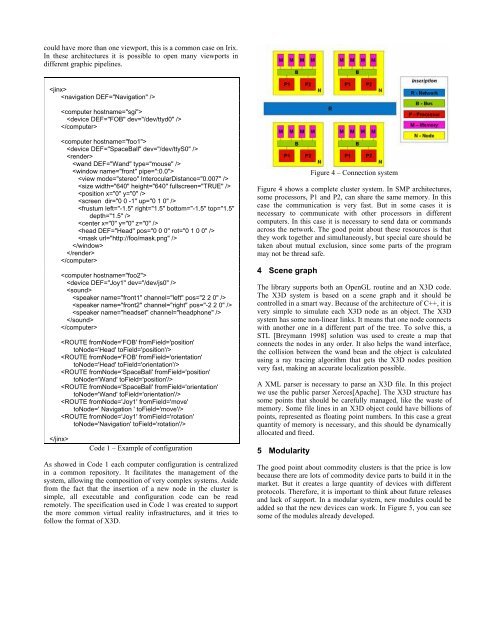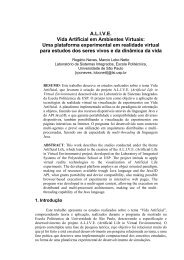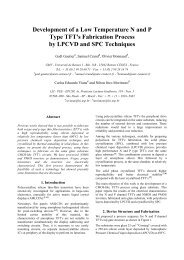JINX: An X3D Browser for VR Immersive Simulation ... - LSI - USP
JINX: An X3D Browser for VR Immersive Simulation ... - LSI - USP
JINX: An X3D Browser for VR Immersive Simulation ... - LSI - USP
You also want an ePaper? Increase the reach of your titles
YUMPU automatically turns print PDFs into web optimized ePapers that Google loves.
could have more than one viewport, this is a common case on Irix.<br />
In these architectures it is possible to open many viewports in<br />
different graphic pipelines.<br />
<br />
<br />
<br />
<br />
<br />
<br />
<br />
<br />
<br />
<br />
<br />
<br />
<br />
<br />
<br />
<br />
<br />
<br />
<br />
<br />
<br />
<br />
<br />
<br />
<br />
<br />
<br />
<br />
<br />
<br />
<br />
<br />
<br />
<br />
<br />
<br />
Code 1 – Example of configuration<br />
As showed in Code 1 each computer configuration is centralized<br />
in a common repository. It facilitates the management of the<br />
system, allowing the composition of very complex systems. Aside<br />
from the fact that the insertion of a new node in the cluster is<br />
simple, all executable and configuration code can be read<br />
remotely. The specification used in Code 1 was created to support<br />
the more common virtual reality infrastructures, and it tries to<br />
follow the <strong>for</strong>mat of <strong>X3D</strong>.<br />
Figure 4 – Connection system<br />
Figure 4 shows a complete cluster system. In SMP architectures,<br />
some processors, P1 and P2, can share the same memory. In this<br />
case the communication is very fast. But in some cases it is<br />
necessary to communicate with other processors in different<br />
computers. In this case it is necessary to send data or commands<br />
across the network. The good point about these resources is that<br />
they work together and simultaneously, but special care should be<br />
taken about mutual exclusion, since some parts of the program<br />
may not be thread safe.<br />
4 Scene graph<br />
The library supports both an OpenGL routine and an <strong>X3D</strong> code.<br />
The <strong>X3D</strong> system is based on a scene graph and it should be<br />
controlled in a smart way. Because of the architecture of C++, it is<br />
very simple to simulate each <strong>X3D</strong> node as an object. The <strong>X3D</strong><br />
system has some non-linear links. It means that one node connects<br />
with another one in a different part of the tree. To solve this, a<br />
STL [Breymann 1998] solution was used to create a map that<br />
connects the nodes in any order. It also helps the wand interface,<br />
the collision between the wand bean and the object is calculated<br />
using a ray tracing algorithm that gets the <strong>X3D</strong> nodes position<br />
very fast, making an accurate localization possible.<br />
A XML parser is necessary to parse an <strong>X3D</strong> file. In this project<br />
we use the public parser Xerces[Apache]. The <strong>X3D</strong> structure has<br />
some points that should be carefully managed, like the waste of<br />
memory. Some file lines in an <strong>X3D</strong> object could have billions of<br />
points, represented as floating point numbers. In this case a great<br />
quantity of memory is necessary, and this should be dynamically<br />
allocated and freed.<br />
5 Modularity<br />
The good point about commodity clusters is that the price is low<br />
because there are lots of commodity device parts to build it in the<br />
market. But it creates a large quantity of devices with different<br />
protocols. There<strong>for</strong>e, it is important to think about future releases<br />
and lack of support. In a modular system, new modules could be<br />
added so that the new devices can work. In Figure 5, you can see<br />
some of the modules already developed.

















